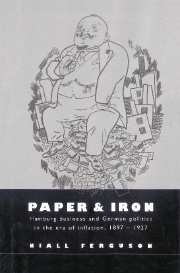Book contents
- Frontmatter
- Contents
- List of figures
- Preface
- List of abbreviations
- Introduction
- 1 Golden years
- 2 The sinews of war
- 3 The political economy of revolution
- 4 Versailles and Hamburg
- 5 Relative stabilisation
- 6 The failure of ‘fulfilment’
- 7 Dissolution and liquidation
- 8 The legacy of the inflation
- Epilogue: Hitler's inflation
- Appendix
- Bibliography
- Index
7 - Dissolution and liquidation
Published online by Cambridge University Press: 14 October 2009
- Frontmatter
- Contents
- List of figures
- Preface
- List of abbreviations
- Introduction
- 1 Golden years
- 2 The sinews of war
- 3 The political economy of revolution
- 4 Versailles and Hamburg
- 5 Relative stabilisation
- 6 The failure of ‘fulfilment’
- 7 Dissolution and liquidation
- 8 The legacy of the inflation
- Epilogue: Hitler's inflation
- Appendix
- Bibliography
- Index
Summary
The bankruptcy of business politics
There had been much rhetoric during 1922 about the need to increase the influence of ‘men of business’ over German policy making. Now that a businessman was Chancellor, the theory of ‘business politics’ could be put into practice. The experiment can scarcely be judged a success. In the course of the nine months during which Wilhelm Cuno held office, the German Reich was brought closer to the brink of dissolution than at any time since its foundation. A Franco-Belgian force occupied the Ruhr. To finance ‘passive resistance’ to this occupation, the production of paper currency was expanded to the limit of the printing presses' capacity. Attempts to arrest its consequent international depreciation failed, as did the strategy of passive resistance itself. Moreover, the increasingly rapid adjustment of prices and wages meant that the process of real monetary contraction which had begun in 1921/2 accelerated, leading to a de facto stabilisation crisis – long before deliberate steps were taken to end inflation. Although the continuing monetary chaos made it possible for firms to avoid overt bankruptcy, lack of liquidity forced many to curtail production and employment. Diminishing economic returns led in turn to political fragmentation. In Bavaria, the state government pursued an increasingly independent course; in Saxony and Thuringia, the Communists steadily increased their influence; while the secession of the occupied Rhineland became a distinct possibility. But these were only the most overt regional responses to the bankruptcy of the national polity. So great were the centrifugal forces at work, that even Hamburg, the Chancellor's own state, contemplated economic secession from the Reich.
- Type
- Chapter
- Information
- Paper and IronHamburg Business and German Politics in the Era of Inflation, 1897–1927, pp. 364 - 407Publisher: Cambridge University PressPrint publication year: 1995



